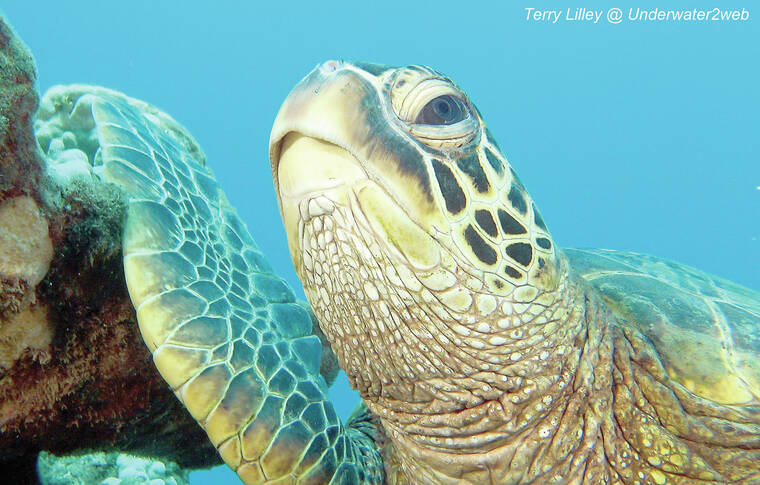Most of our green sea turtles (honu) over the last thousand years have laid their eggs way up in the Northwest Hawaiian Islands. This is truly amazing because when the turtles hatch they have an internal GPS that tells them the exact beach and place on that beach were they hatched.
The baby turtles when they enter the sea swim way offshore for about five years feeding on jellyfish. They live in the deep water because there are few sharks and other predators to eat them way out at sea.
After their time at sea, when they are about 18 to 20 inches long, they swim thousands of miles and end up on our coral reefs here in the main Hawaiian Islands and switch to feeding on limu (seaweed).
Our sea turtles’ amazing adventure has just begun because 20 years or so after hatching they swim all the way back to the Northwest Hawaiian Islands to lay their eggs on the sandy beach where they were hatched. How the turtles can swim 1,500 miles in the open sea and end up exactly where they hatched is still a mystery. The only problem is the beach where they were hatched is now gone.
Several years ago, a Category 5 hurricane wiped out the main coral atolls where most of our green sea turtles laid their eggs. These atolls were only about 5 feet above sea level and the hurricane removed all the sand the turtles need to lay their eggs in, and rising sea levels have now covered the atolls for good.
Many of our honu go all the way to the Northwest Hawaiian Islands to lay eggs, and then they have to come all the way back to the main Hawaiian Islands to find a beach to lay their eggs on. Often with turtles if they do not lay their eggs within a certain period of time, they will become egg bound and die.
This is a huge problem for our entire sea turtle population because it puts a stress on the pregnant females, who have to swim hundreds to thousands of miles to find a wide, soft sandy beach to lay eggs.
Over the past two years many of our sea turtles are now laying eggs on Kaua‘i and O‘ahu beaches, but the beach is covered with buildings and sea walls.
Sea turtles need to lay their eggs in just the perfect humidity and moisture, and that means they need a beach 30 to 40 feet wide and 10 feet deep or their eggs won’t hatch.
On the North Shore of O‘ahu this year, I saw dozens of sea turtles trying to lay eggs right in front of homes on beaches that were so small it is not likely the eggs will ever hatch as the surf will just wash them away.
Due to the threat of rising sea levels and hurricane activity, us humans are going to have to set aside beaches for our honu to nest on if we want them to survive into the future. That means that seawalls and coastal homes may need to be removed or set back so the beach is suitable for turtle nests.
We have a lot of sea turtles right now in Hawai‘i and they bring in millions of dollars from tourism, but that may all change in the future if they cannot reproduce due to humans living on their future nesting sites.
•••
Terry Lilley is a marine biologist living in Hanalei Kaua‘i and co-founder of Reef Guardians Hawai‘i, a nonprofit on a mission to provide education and resources to protect the coral reef. To donate to Reef Guardians Hawaii go to www.reefguardianshawaii.org.






This article has some major inaccuracies. Many of the atolls where the turtles lay their eggs are not covered for good. That is just plain wrong. Turtles still swim to the French Frigate Shoals and successfully lay their eggs there. It is shocking that this author and this newspaper allow such misinformation to be published.
All true. Just trust the US experts twisting the truth. Are we a state or not?